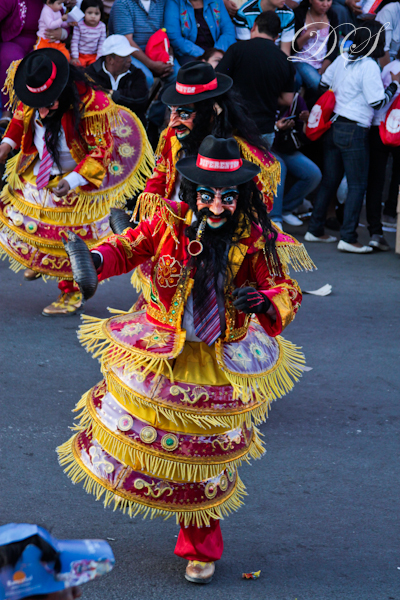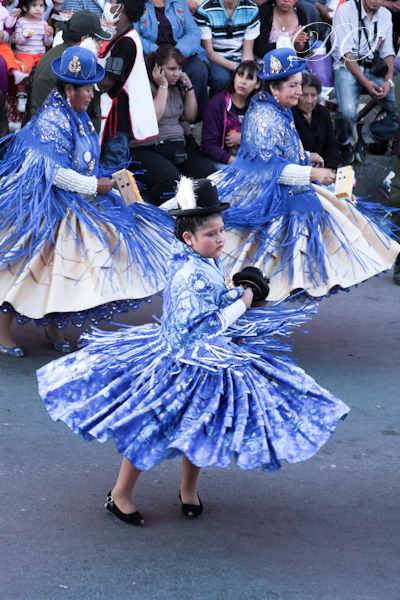Niedawno, bo 4 sierpnia 2013 roku, zorganizowano happening pod haslem: “Morenada100% Boliwijska : dla światowego pokoju i poszanowania kultury Boliwii” (Morenada 100% Boliviana: por la paz mundial y el Respeto a la Cultura Boliviana), w którym wziely udzial tysiące tancerzy, w 76 miastach w 23 krajach na całym świecie. Wydarzenie to zostało zorganizowane przez rzad Boliwii, aby pokazać światu, że taniec narodzil sie wlasnie w tym panstwie.
O co tyle halasu?
Morenada (czyli w wolnym tlumaczeniu: ‘taniec czarnych niewolników’) jest tańcem pochodzacym z boliwijskich Andow, charakteryzujacy się mieszaniną elementów afrykańskich i rodzimych.
Geneza tego tanca jest szeroko dyskutowana wśród specjalistów, ale główne hipotezy mówią, że taniec ten byl inspirowany losem afrykańskich niewolników sprowadzonych do Boliwii do pracy w kopalni srebra w Potosi. Chociaz nie ma dowodów na to, że afrykańscy niewolnicy rzeczywiście pracowali w kopalni, istnieje wiele przeslanek, że byli oni zatrudnieni w Casa de la Moneda (mennicy), co było równie wykanczajace i zabójcze. Ogromny jęzor ciemnych masek ma symbolizować wlasnie stan fizyczny tych pracowników, a grzechotanie Matracas, uzywanych podczas tanca przez dostojne Cholitas, jest często porownywane do grzechotania niewolniczych łańcuchów. W tym kontekscie, Morenada reprezentuje bunt afrykańskich niewolników.
Inna teoria głosi, że inspiracją dla tanca bylo tłoczenie winogron do produkcji wina przez afro-boliwijska spolecznosc zamieszkająca region Yungas, La Paz. Zgodnie z ta teoria, cylindryczne kostiumy Morenady stanowiłoby nawiazanie do beczek wina. Chociaz w regionie Yungas nigdy nie było żadnej uprawy wina, co sprawia, że teoria wydaje się raczej nieprawdopodobna, to teksty śpiewane w Morenadzie zawieraja aluzje do uprawy winorośli. Ponadto, historia pokazuje, iz afro-boliwijczycy zatrudnieni byli przy pracy w winnicach w innych regionach, na przyklad w Chuquisaca (Sucre).
Trzecia teoria wiaze taniec z kulturą Aymara, z powodu jaskiniowych malowideł znalezionych nad brzegiem jeziora Titicaca, na półwyspie Taraco. Malowidla, około 200/300- letnie ukazywaly tancerzy, ubranych w stoje przypominajace te z Morenady, ktore do dzis sa zreszta produkowane w okolicy. Miejsce to mialo byc kolebka “Tanca ryb” jak nazywana jest w tych okolicach Morenada.
Przy okazji strojow – Morenade mozna czasem pomylic z Caporales, a to dlatego, ze w obu tancach uczestnicza wspolczesnie mlode dziewczyny, ubrane w kuse spodniczki i kozaczki na bardzo wysokich obcasach. W zasadzie odroznia je tylko wyglad nakrycia glowy – w Caporales sa to male melonki, w Morenadzie kapelusze ozdobione piorami. Tak mi sie przynajmniej wydaje, ale moge sie mylic! A wiec, w jednym tancu przeplataja sie mlode dziewczyny, dostojne panie z grzechotkami oraz wspomniani panowie w ‘beczkowych’ przebraniach i maskach (choc w Boliwii panuje rownouprawnienie i kobiety tez moga tanczyc w beczkach:). Dla kazdego cos dobrego!
Jakiekolwiek było pochodzenie tanca, w 2011 roku Morenada została zadeklarowana przez rzad: Niematerialnym Dziedzictwem Kulturalnym Wielonarodowego Panstwa Boliwii . po to, by powstrzymać próby zawłaszczenia Morenady przez sąsiadów, zwłaszcza Peru i Chile, ktorzy roszcza sobie ‘prawa’ takze do innych tancow boliwijskich.
Ja osobiscie uwazam, że dyskurs o Morenade jest troche rozdmuchany, ale nie calkiem bezpodstawny. Jak wiemy z historii, Boliwia straciła połowę swojego terytorum w XIX wieku, nie ma wiec nic dziwnego w tym, iz niektóre elementy kultury i tradycji Boliwii zmieszaly się z tymi w krajach sąsiedzkich, ale o swoje trzeba walczyc (o czym wiemy my Polacy przy okazji rozmow o wodce, oscypkac czy ogorkach kiszonych:). Popularność tego tańca na różnych festiwalach w Boliwii jest niezwykla. Karnawal lub święta religijne przyciagaja tysiace tancerzy i muzykow z całego kraju, by oddac czesc wierze, tradycji, ale rowniez celebrowac zycie. Są to zwykli ludzie, które oddychaja tradycja na co dzień, jak i studenci, ktorych marzeniem jest wziąć udział w Carnawale co najmniej raz w życiu. W zasadzie, każdy potencjalny tancerz jest mile widziany, jeśli tylko moze sobie pozwolić na zakup tych wymyslnych recznie szytych strojow!
Muszę przyznac, iz nigdzie indziej nie doświadczyłam takiego pokazu narodowej dumy, jak tu, w Boliwii i mam nadzieję, że to nigdy się nie zmieni! Boliwijczycy sa : ‘Orgulosos de ser Bolivianos’:)
Najpopularniejsze festiwale w Boliwii, gdzie można zobaczyć Morenade i inne tradycyjne tance to: Carnaval de Oruro (Oruro), Fiesta del Gran Poder (La Paz), Fiesta de Urkupiña (Cochabamba), Fiesta de Ch’utillos (Potosi), Entrada de la Virgen de Guadalupe (Chuquisaca), Festividad de la Virgen del Carmen (La Paz y Santa Cruz), Jisk’a Anata (La Paz) Entradas Universitarias (La Paz, Cochabamba y Tarija), Corso de corsos (Cochabamba) etc.
Jednym slowem, przybywajac do Boliwii (nie wazne kiedy), masz duze szanse na wziecie udzialu w paradzie zycia:)
Zrodla: Wikipedia oraz moja wlasna wiedza, poparta doswiadczeniem. Wszystkie swieta Boliwii wraz z datami znajdziesz na stronie anglojezycznej ‘Bolivia Bella’. Jezeli chcesz zobaczyc wiecej zdjec, kilknij ‘tutaj‘
***
Recently, on August 4 2013 a historic event “100% Bolivian Morenada: for world peace and Bolivian Culture Respect” (Morenada 100% Boliviana: por la paz mundial y el Respeto a la Cultura Boliviana) had happened, in which thousands of people danced Morenada in 76 cities in 23 countries worldwide. This event was organized by the Bolivian gouverment in order to show the world, that dance is purely Bolivian.
What was all that about?
The Morenada (which means: Dance of the Black Slaves) is a music and dance style from the Bolivian Andes characterized by a mixture of African and native elements. The origins of this dance are debated among specialists, but the main hypotheses say that the dance could have been inspired by African slaves brought to Bolivia to work in the silver mines of Potosí. However, there is no evidence that these African slaves actually worked in the mines, although there is much evidence that they worked in the Casa de la Moneda (mint) in the production of coins, which was equally deadly. The enormous tongue of the dark masks is meant to represent the physical state of these mines workers and the rattling of the Matracas are frequently associated with the rattling of the slaves’ chains. In this sense, Morenada represents rebellion of the African slaves.
Another theory states that it would be inspired by the Afro-Bolivian community living in the Yungas region of La Paz and the stamping of grapes for the wine production. According to this, the barrel-like Moreno-costumes would represent the barrel containing the wine. However, in the Yungas region there has never been any wine cultivation. At first sight this makes the theory seem extremely unprovable, but the texts sung in the Morenada contain hints to wine cultivation. In addition, the historical records show that there were afro-Bolivians working in vineyards in other regions, such as Chuquisaca (Sucre).
The third main theory links this dance with the Aymara culture due to the findings of cave paintings in the Lake Titicaca shores in the Taraco peninsula.
Places like Achacachi claim to be the place of origin of the “Fish Dance” as the Morenada in this region also is referred to. There were some murals of about 200–300 years of age found in the region, showing Morenada dancers and there still is a strong tradition of making elaborately embroidered Morenada costumes.
About costumes – Morenada can sometimes be confused with Caporales (especially by someone like me), and that’s because in both dances there are young girls dressed in short skirts and boots on a high-high heels. I distinguish them only by their hats – in Caporales they are round and small, while in Morenada the hats are decorated with feathers. I think so? But meybe I am wrong. Thus, in one dance there are young girls dancing alongside elegant ladies with rattles and gentlemen in ‘barrel-like’ costumes and masks (there is an equality in Bolivia and ladies can also dance in a barrels:). Something for everybody!
Whatever was the origin, in 2011 through a Supreme Decree the Morenada was declared Intangible Cultural Heritage of the Plurinational State of Bolivia. This measure was taken to stop the attempts of appropriation by neighbor countries, especially Peru and Chile.
I think that the discurs about Morenada is due to fact that Bolivia lost half of its teritory in XIX Century, so there is nothing strange that some parts of Bolivian culture and traditions mixed up with those in neighbour countries. I have no say in this debate as I’ve seen Morenada danced only in Bolivia, but popularity of this dance during different festivalities speaks for itself and I think that is important to ‘fight for what’s yours’ (as we Polish know best, when it comes to discussing vodka, oscypki or pickled cucumbers:). Carnaval or religious festivals bring thousands of dancers and musiciants from all over the country to celebrate life itself. Those are regular people, that live the tradition on a daily basis as well as students who want to take part in a Carnaval at least once in their life. To be honest, everybody is welcome to dance, if only can afford these elaborate costumes! I was tempted, and althought I am not a dancer, I love especially Tinkus’ music, style and beautiful dresses:)
I must say, that I’ve never experienced such a showcase of national pride than here, in Bolivia and I hope that it will never change! Bolivians are ‘Orgulosos de ser Bolivianos’!
The most popular festivals in Bolivia, where you can see Morenada and other dances are:
Carnaval de Oruro (Oruro), Fiesta del Gran Poder (La Paz), Fiesta de Urkupiña (Cochabamba), Fiesta de Ch’utillos (Potosí)
Entrada de la Virgen de Guadalupe (Chuquisaca), Festividad de la Virgen del Carmen (La Paz y Santa Cruz), Jisk’a Anata (La Paz), Entradas Universitarias (La Paz, Cochabamba y Tarija), Corso de corsos (Cochabamba) etc.
In short, coming to Bolivia on holiday, there is a big chance you could take part in a parade of your life:)
Sources: Wikipedia and my self knowledge backed by experience. To check other celebrations ad their dates visit an amazing ‘Bolivia Bella’ website. To see more pictures click ‘here’.
Photo: ‘Los Tiempos’.







